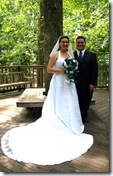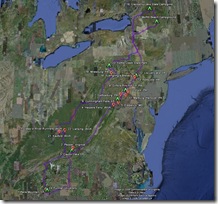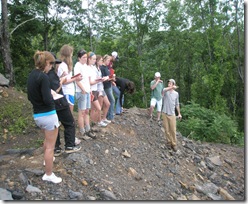Well, it’s been over a year since I left the "Furman Bubble" and I certainly miss it! I
am working as a Graduate Environmental Scientist for URS Corporation in the Philadelphia suburbs. I currently split my time between field work and office work, which I love. A typical day in the office may include anything from writing remedial action reports to the State, drawing contour maps, making graphs and figures, and logging soil characteristics. So far, my field work has included a plethora of groundwater sampling events, using GeoProbe direct push, RotoSonic Drilling, oily sludge recovery, various land restoration activities (i.e. rebuilding vegetation), and cone penetration testing. For me, the field work is much more exciting and feels less like "work" than being in the office.
I have used a lot more from my undergraduate education at Furman than I ever imagined! My professors and diverse course work sent me off into the Environmental Industry very well prepared. The experience of writing an undergraduate thesis was particularly helpful in showing my Project Managers and other colleagues that I knew how to write scientifically. Many young people have limited writing skills, which ultimately limits the work they can perform. One thing I might suggest to Furman seniors and/or recent graduates looking for jobs in the industry is FIELD CAMP. Field camp isn’t just for those going to graduate school. It may cost you up front, but it will pay off if you plan to work as a geologist/environmental scientist. Many real-world projects include tasks like hiking and mapping, interpreting geologic structures, using a Brunton, etc. If you are waiting to hear from employers about jobs and are looking for something to do – go to field camp! It will look great on your resume and boost your confidence when you eventually work on those types of projects. The first year out of college flew by, as everyone said it would, but I am very satisfied with the start of my career!
– SunnyRae Granger
Dr. Garihan publishes Geologic Map of Landrum Quad
John M. Garihan just published the Geologic map of the Landrum 7.5-minute quadrangle with the support of the SC Geologic Survey. It is available to the public through the SCDNR website, along with 12 other 1:24,000 scale maps mapped by J. Gariha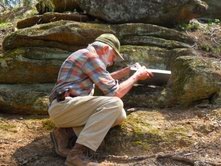 n and W. A. Ranson in upstate South Carolina. These GQM and MS series maps can be viewed and obtained from:
n and W. A. Ranson in upstate South Carolina. These GQM and MS series maps can be viewed and obtained from:
http://www.dnr.sc.gov/geology/publications.htm
Click on General Geologic Map Series. The Tigerville and Saluda quadrangle geologic maps are in their final preparation phases, to be available this fall or next spring. These maps are used by the public for recreational and hiking purposes, for the general interest of scientifically literate individuals, and for planning purposes by city planners, among many other uses like siting water wells etc.
Watch out for “The National Parks: America’s Best Idea” on PBS starting September 27th
 Filmed over the course of more than six years at some of nature’s most spectacular locales — from Acadia to Yosemite, Yellowstone to the Grand Canyon, the Everglades of Florida to the Gates of the Arctic in Alaska — THE NATIONAL PARKS: AMERICA’S BEST IDEA is nonetheless a story of people: people from every conceivable background — rich and poor; famous and unknown; soldiers and scientists; natives and newcomers; idealists, artists and entrepreneurs; people who were willing to devote themselves to saving some precious portion of the land they loved, and in doing so reminded their fellow citizens of the full meaning of democracy. It is a story full of struggle and conflict, high ideals and crass opportunism, stirring adventure and enduring inspiration – set against the most breathtaking backdrops imaginable.
Filmed over the course of more than six years at some of nature’s most spectacular locales — from Acadia to Yosemite, Yellowstone to the Grand Canyon, the Everglades of Florida to the Gates of the Arctic in Alaska — THE NATIONAL PARKS: AMERICA’S BEST IDEA is nonetheless a story of people: people from every conceivable background — rich and poor; famous and unknown; soldiers and scientists; natives and newcomers; idealists, artists and entrepreneurs; people who were willing to devote themselves to saving some precious portion of the land they loved, and in doing so reminded their fellow citizens of the full meaning of democracy. It is a story full of struggle and conflict, high ideals and crass opportunism, stirring adventure and enduring inspiration – set against the most breathtaking backdrops imaginable.
More information and preview at: http://www.pbs.org/nationalparks/
Ivan & Courtney Irizarry
Rock Garden at the Townes Science Center
The landscape (rock and botanic garden) around Charles H. Townes Science Center has been designed to reflect the geologic and botanical variations observed from the mountains to the ocean in South Carolina and Southern Appalachian in general. The rock garden contains numerous large specimens collected from mines in the Southern Appalachian region. A new website has been launched to help people see the landscape and learn about the rocks.
Please visit the web page at : http://ees.furman.edu/rockgarden/
Brittany DeKnight is coming back to Furman
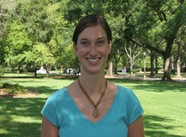 Brittany DeKnight (2007 graduate of EES) is coming back to Furman to join the Center for Sustainability as an Associate Director starting July 2009. She is currently completing her Masters degree in Sustainability, and is among the first batch of students to graduate from the School of Sustainability at Arizona State University.
Brittany DeKnight (2007 graduate of EES) is coming back to Furman to join the Center for Sustainability as an Associate Director starting July 2009. She is currently completing her Masters degree in Sustainability, and is among the first batch of students to graduate from the School of Sustainability at Arizona State University.
Congratulations Lehne!

Lehne Slater, a 2007 graduate of Earth and Environmental Sciences Department, Furman University completed her Masters degree in Geology from the University of Kentucky. We wish her the best!
Appalachian Geology: First EES May-Term Field Trip
Dr. Garihan and Dr. Ranson lead a group of 8 students on a field trip to study the Mid-Atlantic Appalachian Geology starting from Virginia and ending at the Adirondacks in Upstate New York. Their trip highlights include among other things, a study of mountain top removal and its impacts, geology and geomorphology of American civil war sites in Gettysburg and a visit to the Yuengling Brewery, the oldest brewery in America.
Volunteering at Furman’s Organic Farm
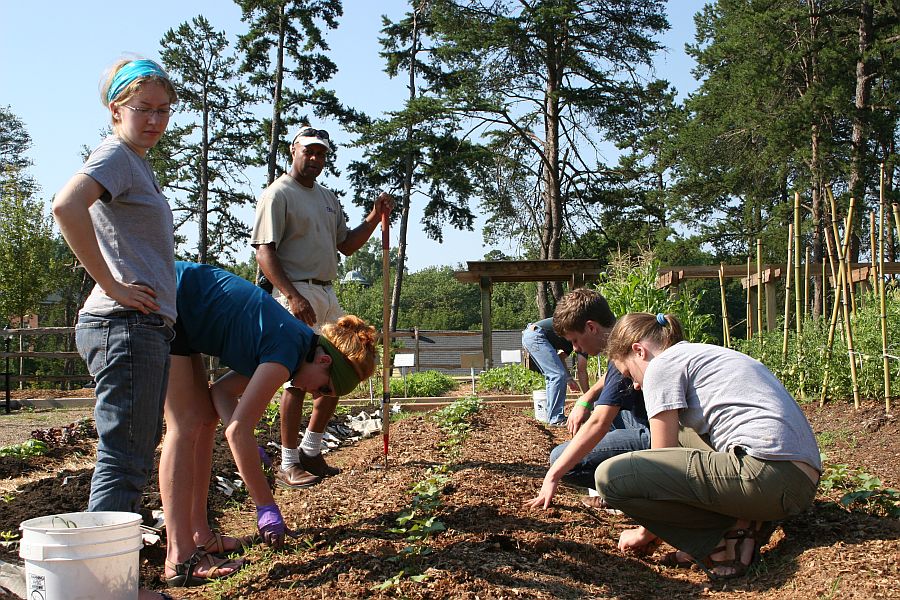
Summer research students from RBRI program volunteering at the Organic Farm located at Duke Energy Village on campus. The farm manager Bruce Adams oversees and helps the stuednts.
Welcome!
Welcome to the Earth and Environmental Sciences blog site at Furman Blogs. We are intending to use this blog to update friends of the department on the latest happenings, news from faculty, students and alumni, and local events of interest to every one.
If you want to have any information posted here, please contact Nina.Anthony@furman.edu or one of the faculty members.
